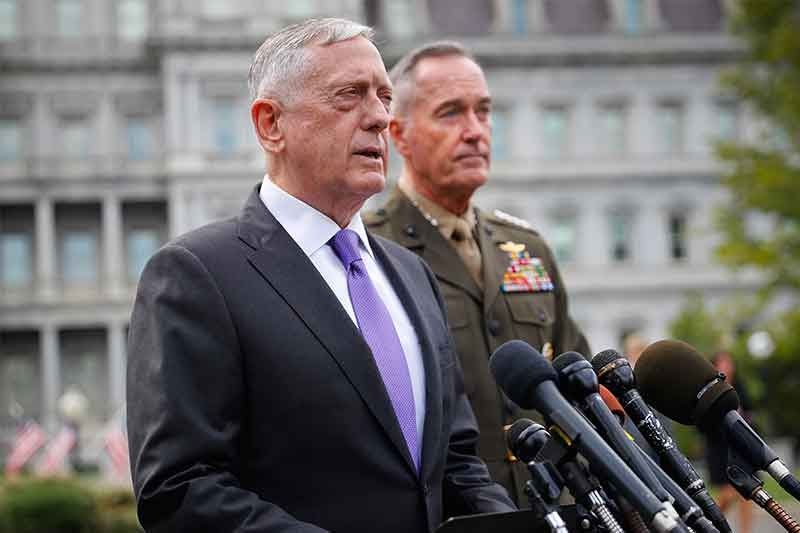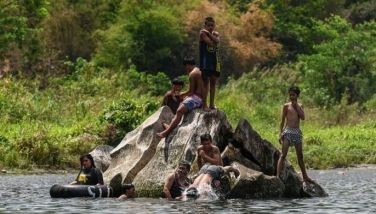US defense chief hits SCS ‘intimidation’

MANILA, Philippines — China’s placement of weapons systems on manmade islands in the South China Sea is designed to intimidate and coerce others in the region, US Defense Secretary Jim Mattis said yesterday.
Mattis laid out a sharp criticism of Beijing at the Shangri-La Dialogue in Singapore, threatening larger consequences if militarization continues.
He warned that America’s recent move to disinvite China from a multinational naval exercise this summer was an “initial response” to the militarization.
It was a “relatively small consequence, I believe there are much larger consequences in the future,” he said.
China relying on muscle to use weapons to pursue goals not favored by international tribunals “is not a way to make long-term collaboration the rule of the road in a region that’s important to China’s future,” Mattis said, when asked to elaborate more on the consequences.
“There are consequences that will continue to come home to roost, so to speak, with China, if they don’t find a way to work more collaboratively with all of the nations who have interests,” he said.
Mattis said the US remains committed to ensuring free and open transit in the region, and that he doesn’t believe China’s actions will pay off.
Militarizing the islands, Mattis said, will not enhance China’s standing in the world.
“Despite China’s claims to the contrary, the placement of these weapons systems is tied directly to military use for the purposes of intimidation and coercion,” Mattis said, referring to the recent deployment of anti-ship missiles, surface-to-air missiles, electronic jammers and other equipment on the Spratly Islands, and the landing of bomber aircraft at Woody Island.
Mattis also struck at one of the key, longstanding disputes between the US and China, telling the international security forum in Singapore that America will continue to provide defense equipment and services to Taiwan and oppose any effort to alter the status quo. China claims the self-governing island as its territory to be brought under control by force if necessary.
But in a quick pivot, Mattis said the US welcomes cooperation with China “wherever possible,” and announced that he has accepted Beijing’s invitation to visit there soon. It remains to be seen if that invitation will stand after the Singapore conference.
Mattis’ comments triggered an equally pointed reaction from a Chinese official at the meeting.
Senior Col. Zhao Xiaozhuo said a US move a couple of years ago to send two warships into China’s “territorial waters” was a violation of law, and an “obvious provocation to China’s national security and territorial integrity.”
Mattis responded that the question reflected a fundamental disconnect with the way international tribunals have spoken on the matter.
“We do not see it as a militarization by going through what has traditionally been an international water space,” said Mattis of the US ship movements through the South China Sea. “What we see it as, is a reaffirmation of the rules-based order.”
Last week the US withdrew an invitation for Beijing to participate in the exercise known as Rim of the Pacific. China had participated in 2014 and 2016.
The Philippines, often acting as an observer in the drills, will now actively participate in the exercise and deploy two warships under Philippine Naval Task Force (NTF).
The Pentagon said the decision to disinvite the Chinese Navy was triggered by what it called strong evidence that China has deployed weapons systems on the islands, and called on Beijing to remove them.
China says it is within its rights to build up defenses on islands in the South China Sea that it believes are its sovereign territory.
China’s activities, Mattis said in his speech yesterday, stand “in stark contrast to the openness of what our strategy promotes; it calls into question China’s broader goals.”
Texas Rep. Mac Thornberry, chairman of the Armed Services Committee who was attending the conference, said China is alienating other nations and nations must band together and say the actions are unacceptable.
The US response to China’s weaponization of the islands continued on Sunday, as two US warships sailed close to the Paracel Islands, which lie north of the Spratlys. It was the latest freedom of navigation operation designed to challenge Beijing’s claims. China protested the maneuver.
In recent years, the US had sought to stabilize military relations with China, but the militarization of the islands has been a persistent point of conflict. Many nations fear that Beijing will use the construction on the islands to extend its military reach and potentially try to restrict navigation in the South China Sea.
China’s delegation at the conference is being led by Lt. Gen. He Lei, vice president of the People’s Liberation Army (PLA)’s Academy of Military Science.
China has not sent high-level officials to the three-day meeting, in an apparent attempt to deflect attention from its campaign to expand sovereignty across virtually the entire South China Sea.
Mattis made clear that the US does not expect nations to choose between the US and China, adding that Beijing should have a voice in shaping the region, while allies have a voice in shaping China’s role.
The US, Mattis said, “will continue to pursue a constructive, results-oriented relationship with China, cooperation when possible, and competing vigorously where we must.”
End game
A senior research fellow at Bangkok Thammasat University’s faculty law and visiting professor at Thailand’s Royal Military Academy warned China’s military buildup in the South China Sea is in support of a long range island-hopping invasion plan of all islets and features in the region currently occupied by other claimant-states.
Testifying recently before US Congress, retired US Navy captain James Fanell said the PLA has dramatically increased the size of its Marines troops and already developed amphibious assault ships and vehicles in preparation for occupying the whole South China Sea.
He pointed out the most important aspect of China’s maritime domination plan involves the act of physically occupying islands within the First and Second Island Chain in the South and East China Sea.
All Spratlys-claimant states except Brunei have military outposts in the disputed archipelago in South China Sea — the Philippines has nine military outposts, Vietnam has more than 23, Malaysia three and Taiwan with one occupied island. China on the other hand has seven military outposts, all man-made islands.
China’s First Island Chain is located within South China Sea’s Spratlys and the Paracels while the Second Island chain stretches from northernmost of South China Sea towards the East China Sea and the Pacific Ocean passing by the island state of Taiwan. China considers Taiwan as a renegade province.
Fanell said Chinese marines have been conducting amphibious island-seizing exercises in the South China Sea utilizing amphibious dock landing ships, air-cushion landing craft and ship-borne helicopters.
He noted this type of training is ubiquitous across the South and East China Sea.
“These (Chinese marine activities) are the most tangible evidence of the People’s Liberation Army intention of being prepared to conduct such mission,” Fanell said, as quoted by Bangkok-based Asia Times.
Out to support China’s future military occupation of the Spratlys are its artificial islands which, Fanell said, will serve as amphibious assault staging areas.
Aside from landing long-range nuclear capable bombers on Woody Islands in the Paracels, three of China’s man-made islands in the Spratlys — Fiery Cross Reef, Subi Reef and Mischief Reef — are all missile capable.
Fannel said additional Chinese forces rapidly deployed to those artificial islands to stage expeditionary strike missions would require few facilities or enough space for short-term troop and equipment laydown immediately prior to an assault.
The PLA’s Marine Corps at sea expeditionary capability will be a version of the US Navy-Marine Corps team, Asia Times reported.
As it is currently happening, China has been mimicking all US Navy and Marine Corps capabilities while at sea as shown during the conduct of massive naval drill in the South China Sea. The naval drill was launched by China in response to the presence of three US Strike Groups in the region.
It was also reported that it is planning to expand its Marine force from 20,000 to a corps-level force of 100,000. However, it is expected that this Marine troops expansion will stake another year to become fully operational.
In December last year, Chinese media reported that 30,000 Marines are serving in its three fleets. – Jaime Laude
- Latest
- Trending



























